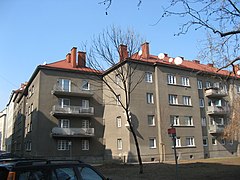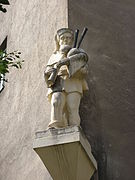Erlachgasse
| Erlachgasse | |
|---|---|
| Street in Vienna | |
| Basic data | |
| place | Vienna |
| District | Favoriten (10th district) |
| Created | 1875 |
| Cross streets | Kempelengasse, Randhartingergasse, Hofherrgasse, Absberggasse , Laimäckergasse, Wilczekgasse, Steudelgasse, Gellert alley Waldgasse, Herndl alley , Wielandgasse , Favoritenstraße , Leibnizgasse, Senefeldergasse, Columbusgasse, Laxenburger Straße , Jagdgasse, Siccardsburggasse, Leebgasse , van der Null Gasse, Alxingergasse , Herzgasse , Eckertgasse, Neilreichgasse , Karmarschgasse, Fernkorngasse |
| Places | Wielandplatz, Viktor-Adler-Platz, Erlachplatz |
| use | |
| User groups | Pedestrians , bicycle traffic , car traffic |
| Road design | one way street |
| Technical specifications | |
| Street length | approx. 2244 m |
The Erlachgasse is a street in the 10th Vienna district, favorites . It was named in 1875 after the Austrian baroque master builder Johann Bernhard Fischer von Erlach .
Location and characteristics
Erlachgasse is a long cross street (around 140 house numbers) in the north of Favoritens, which extends from Kempelengasse in the east to Fernkorngasse in the west. It is a one-way route and is interrupted at the beginning (after crossing the Crete Quarter ) between Absberggasse and Laimäckergasse by a square with sports facilities around the Laaerberg water reservoir of the 1st Vienna High Spring Pipeline . In her run she touches the green areas of the Mundypark, the Wielandpark and the Erlachpark. The Viktor-Adler-Platz with its market breaks the Erlachgasse. After crossing Laxenburger Straße , Erlachgasse runs right through the middle of the tram depot of the Favoriten depot. The development on the alley consists mainly of residential houses from the end of the 19th century to the present, a few commercial establishments and bars. Public transport does not run directly in Erlachgasse, but they can always be found in the immediate vicinity.
Buildings and works of art
No. 11: Relief goat with kid
On this residential complex from the post-war period there is a stoneware relief goat with kid from 1953 by Georg Ehrlich .
No. 53–57: Urban residential complex
After the small park of the Mundypark between Erlachgasse, Steudelgasse and Mundygasse, there is an urban residential complex , built by Franz Wiesmann in 1938 , with two sculptures on the two corners of the house facing the park, bagpiper and flute player (1954) by Theodor Igler. It is a listed building .
No. 63: Relief Fischer von Erlach
The house has a relief by Franz Barwig the Younger , which shows the namesake of Erlachgasse, the architect Johann Bernhard Fischer von Erlach, with his two most famous buildings, the Karlskirche in Vienna and Schönbrunn Palace .
No. 87: Relief mother with children
This house houses the district party organization of the Favoritner ÖVP and has an unspecified relief of a mother with children above the entrance.
No. 88: Sgraffito Fischer von Erlach
The monumental sgraffito on the corner of Erlachgasse and Herndlgasse also refers to the namesake of Erlachgasse, the architect Johann Bernhard Fischer von Erlach. It shows him building the Karlskirche and is signed Langer.
No. 90: Dorotheum
This interesting building, which houses a branch of the Dorotheum , was built in 1928/29 according to plans by the architect Michael Rosenauer . The cubic-block-shaped reinforced concrete building is located on the corner of Wielandgasse (with the actual main front) and is clearly structured by window groups recessed like slits. There is a representative auction room on the first floor. The building is a historical monument.
No. 95: apartment building
This building is a particularly representative apartment building from 1902. It has rich relief decoration in the style of Neomanierism-Neo-Baroque. This is where the men's counseling is located, a special therapy offer for men with relationship, violence and all other forms of problems.
No. 117: Former fittings factory
The whole block between Leebgasse and Van-der-Nüll-Gasse was a former valve and machine factory. The building from the end of the 19th century is made of exposed brick. Such factory buildings, which were very often to be found in Favoriten, have only survived a few today.
literature
- Herbert Tschulk: Viennese district culture guide favorites . Jugend & Volk, Vienna 1985, ISBN 3-224-16255-4
- Dehio Handbook Vienna. X. to XIX. and XXI. to XXIII . District. Anton Schroll, Vienna 1996
Web links
Coordinates: 48 ° 10 ′ 36.7 " N , 16 ° 22 ′ 44.4" E







